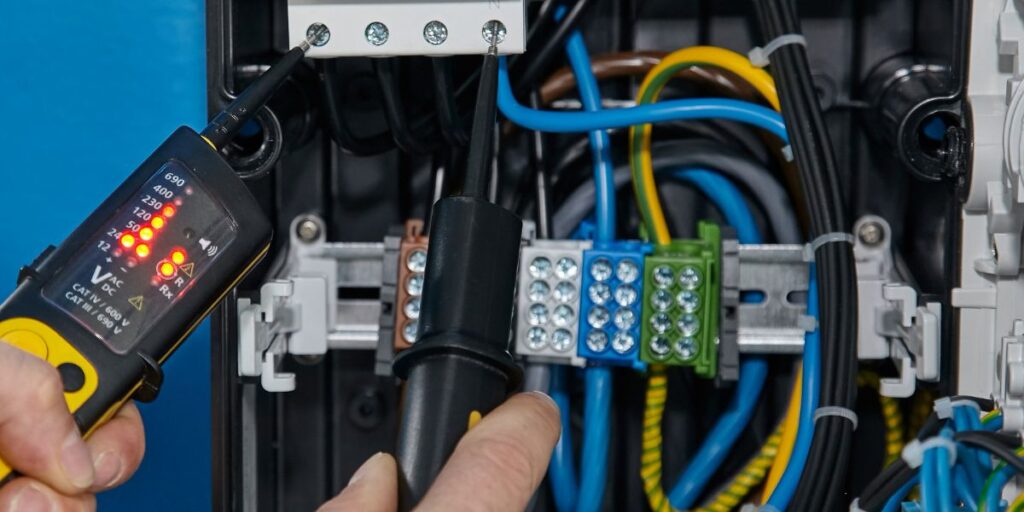What is current and voltage? The goal when getting a foot in the door of electricity and electronics is to grasp simpler concepts like the current firmly.
In this article, the following electrical terms will be described to give their meaning in simpler understanding, so read on! In this article, we will include their basic definitions, and operational functions in electrical circuits and then proceed to answer some questions you may have at the back of your mind.
So, what are current and voltage and why do we care?
What is Current?

Definition of Electrical Current
In other words, electrical current is defined as the movement of electric charge through a conductor or a power-carrying material.
This flow is normally constituted of electrons that move through a substance that includes copper cable. This kind of current describes the quantity of charge that moves through a specific point of the circuit in one-time unit.
The unit of measurement for current is the Ampere (A). One ampere equals the amount of charge that is elementary, which is Coulombs, passing through a given place in one second.
As simple as this, electricity is likened to water in a pipe and the current is the amount of water that passes through the pipe per unit time.
Types of Current
- Direct Current (DC): In DC, the electric charge has a one-way circulation while in AC, can circulate in both directions. DC power is normally sourced from batteries and solar panels are the most popular electrical source today.
- Alternating Current (AC): AC direction is changed from one phase to another. It is the kind of electricity distributed to consumers by electrical networks, mostly in houses and offices.
What is Voltage?
Definition of Voltage
A voltage or electric potential difference is the driving force for electric charges through a conductor. It can be thought of as the ‘force’ or ‘pressure’ that pushes the current through the circuit. Voltage is usually expressed in Volts (V).
To understand voltage think of water pressure in a water tank. Similar to the water force that is applied through pipes, voltage is the force that is used to pass the electrical current through conductors.
Role of Voltage in a Circuit
Current is the flow of charges in an electric current while voltage is a must to xsion of charges. Without voltage, there would be no change in polarity which results in the absence of the flow of charge, hence there is no electrical current.
The main difference is voltage sources such as batteries and generators, supply the amount of energy needed to push the electrons and produce current.
The Relationship Between Current and Voltage

The Relationship Between Current and Voltage
Ohm’s Law
We need to talk about Ohm’s Law to understand how current and voltage interact. Ohm’s Law is a fundamental principle in electronics and states that:
V=I×RV = I \times R
Where:
- VV is the voltage (in Volts),
- II is the current (in Amperes),
- RR is the resistance (in Ohms).
This equation tells us that the voltage across a conductor is equal to the current flowing through it multiplied by the resistance.
In simpler terms, if you increase the voltage, the current will also increase, provided the resistance stays the same.
Practical Implications
From a practical viewpoint, knowledge of the relationship between current and voltage is useful for designing electrical circuits and identifying problems and their solutions within designed electrical circuits.
For example, if a circuit draws say 1000V, there is a tendency that it will be overheated or even burnt out. In a simple circuit, with the use of voltage or resistance, you can regulate the current flowing through the circuit and make sure that it runs to the optimum level.
How Current and Voltage Affect Electrical Devices

How Current and Voltage Affect Electrical Devices
Impact on Appliances
Every device you are using at this moment, starting with the phone you are holding in your hand until the refrigerator in the kitchen, works only with a certain current and voltage.
Electrical or electronic devices have specific amplification levels that must be supplied at any given moment; if the devices receive more or less than the required voltage, they either may not function or may be burnt out.
For instance, an electronic device that is appropriate for 5V of direct current; DC cannot work properly if connected to 220 volts of sequential current; AC.
Likewise, appliances that are manufactured to work on 220V AC cannot work as expected should they be connected to the 110V AC socket.
Safety Considerations
A vital aspect of the same is comprehending the current and voltage which will assist in the safety compartment.
Electrical circuits if not well handled can be very hazardous. High voltage may lead to electricity shock or even fires in the event it is not well handled.
Check to ensure the right voltage and current ratings are used with the electrical appliances; this will reduce accidents and equipment breakdowns.
Measuring Current and Voltage
Tools for Measurement
- Multimeter: An all-around equipment used to measure both current and voltage. It can give a reading in different units and is used for solving electrical problems.
- Clamp Meter: This tool is used to measure current without having to break the circuit. It engulfs a wire and indicates current passing through it.
- Voltage Tester: A tool employed with the simple aim of determining if a circuit is live or not and the voltage levels present therein.
How to Use a Multimeter
A multimeter is used by firstly setting the device to the right mode of measurement that is voltage or current, placing the probes on the circuit, and then reading the values on the meter.
To get precise results, be sure to adhere to certain safety measures and be very careful with the multimeter.
FAQs About Current and Voltage
Can you explain to me what is current and voltage and what is the connection between the two?
Charge is the amount of the electric charge passing through the conductor at the current time while electric force or voltage speaks of the force that propels the flow of the current through the conductor at the current time.
Direct current is in Amperes, and the voltage is in volts. It is a fact that voltage without current is futile while on the same note, current without voltage is also valueless.
What do you understand by voltage and why is sometimes used as electric potential?
Voltage is referred to as electric potential difference since it indicates the magnitude difference of the electric potential between any two points.
The electrical potential energy tells the amount of work done in shifting a charge from one point to the other.
How can Ohm’s Law be used in everyday life?
Ohm is the quantitative application that exemplifies the math between voltage, current, and opposition in the circuit.
When selecting components and designing circuits, it offers a direct mathematical relation to diagnose electrical problems.
What can be the consequence of high current in a circuit?
Over currents in the current level can lead to heating components, causing damage and also raising the potentiality of fire outbreaks.
JMVrental fuses and circuit breakers are safety devices meant to trip and cut the circuit when the current rating has been reached.
What measures should be taken for safely measuring current and voltage?
Specifically when measuring current and voltage, one should use the right tools such as a multimeter, and or follow some set measures of safety.
Make certain that the device is in the right mode to measure in terms of its dimension and be very cautious when handling electrical circuits.
Conclusion
A basis of the functioning of electrical circuits is knowledge of current and voltage as two principal parameters.
Current is the electric charge at the present, while voltage is the impetus that instigates the current. After reading how these two quantities depend on each other, you will be able to design and understand electrical applications to the elementary appliances in use or even to the advanced electronic gadgets.
From Ohm’s Law to the practical steps of measurement, understanding the current and voltage, as well as the impact they make on circuits put you in a good place to handle the electrical current safely and productively.
These concepts are probably the most important that you use every week, whether you’re handling a troubleshooting job or when you are involved in a circuit design.




